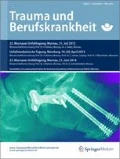Zusammenfassung
Es werden die 5 Kadiläsionen (3 im Bereich des Ellenbogens, eine im Bereich des Knies und eine im Bereich des oberen Sprunggelenks) beschrieben. Es handelt sich meist um klinisch und radiologisch unscheinbare Verletzungen, die wegen ihrer komplexen Problematik primär erkannt und korrekt behandelt bzw. ausgeschlossen werden müssen, um spätere gravierende Komplikationen zu vermeiden. Diese 5 Verletzungen, ihre Problematik und Primärtherapie werden dargestellt.
Abstract
The five“kadi” lesions (three in the elbow, one in the knee and one in the ankle joint) will be described. They are mostly clinically and radiologically inconspicuous injuries which must be primarily recognized and correctly treated or excluded because of the complex associated problems in order to avoid delayed serious complications. These five injuries, the associated problems and primary therapy will be presented.




Literatur
Al-Aubaidi Z, Lundgaard B (2011) Genu valgum after proximal metaphyseal tibial fracture in children. Ugeskr Laeger 173:1799–1801
Cottalorda J, Beranger V, Louahem D et al (2008) Salter-Harris type III and IV medial malleolar fractures: growth arrest: is it a fate? A retrospective study of 48 cases with open reduction. J Pediatr Orthop 28:652–655
Hasler CC, Laer LR von (1998) Schraubenosteosynthese bei dislozierten Frakturen des Condylus radialis humeri im Wachstumsalter. Unfallchirurg 101:280–286
Hasler CC, Laer LR von (2001) Prevention of growth disturbances after fractures of the lateral humeral condyle in children. J Pediatr Orthop B 10:123–130
Hasler CC, Laer L von, Hell AK (2005) Open reduction, ulnar osteotomy and external fixation for chronic anterior dislocation of the head of the radius. J Bone Joint Surg Br 87:88–94
Kemnitz S, De Schrijver F, De Smet L (2000) Radial head dislocation with plastic deformation of the ulna in children. A rare and frequently missed condition. Acta Orthop Belg 66:359–362
Kim HT, Conjares JN, Suh JT, Yoo CI (2002) Chronic radial head dislocation in children, Part 1: pathologic changes preventing stable reduction and surgical correction. J Pediatr Orthop 22:583–590
Laer LR von, Hasler CC (2000) Mechanical dynamics in supracondylar fractures of the humerus in children. Tech Orthop 15:30–37a
Laer L von, Kraus R, Linhart W (2012) Frakturen und Luxationen im Wachstumsalter, 6 Aufl. Thieme, Stuttgart New York
Mubarak SJ, Kim JR, Edmonds EW et al (2009) Classification of proximal tibial fractures in children. J Child Orthop 3:191–197
Riebel T, Nasir R (1995) Sonographie geburtstraumatischer Extremitätenläsionen. Ultraschall Med 16:196–199
Saraf SK, Khare GN (2011) Late presentation of fractures of the lateral condyle of the humerus in children. Indian J Orthop 45:39–44
Schneidmueller D, Gercek E, Lehnert M et al (2011) Proximale Tibiafrakturen. Unfallchirurg 114:396–402
Sulaiman AR, Munajat I, Mohd EF (2011) A modified surgical technique for neglected fracture of lateral humeral condyle in children. J Pediatr Orthop B 20:366–371
Vocke-Hell AK, Schmid A (2001) Sonographic differentiation of stable and unstable lateral condyle fractures of the humerus in children. J Pediatr Orthop B 10:138–141
Weinberg AM, Castellani C (2006) Epikondyläre und kondyläre Humerusfrakturen, Ellenbogenluxationen. In: Marzi I (Hrsg) Kindertraumatologie. Steinkopff, Darmstadt
Zhang JD, Chen H (2008) Ultrasonography for nondisplaced and mini-displaced humeral lateral condyle fractures in children. Chin J Traumatol 11:297–300
Interessenkonflikt
Der korrespondierende Autor gibt für sich und seine Koautoren an, dass kein Interessenkonflikt besteht.
Author information
Authors and Affiliations
Corresponding author
Rights and permissions
About this article
Cite this article
von Laer, L., Veigel, B. & Illian, C. Die Kadiläsionen. Trauma Berufskrankh 14, 247–254 (2012). https://doi.org/10.1007/s10039-012-1922-5
Published:
Issue Date:
DOI: https://doi.org/10.1007/s10039-012-1922-5

